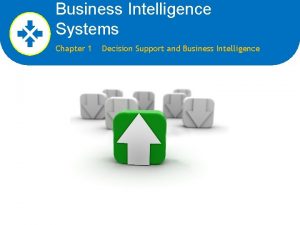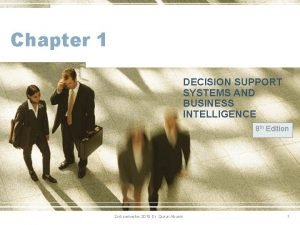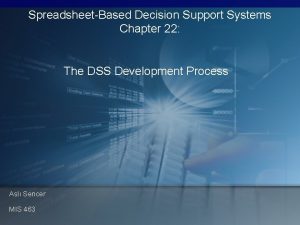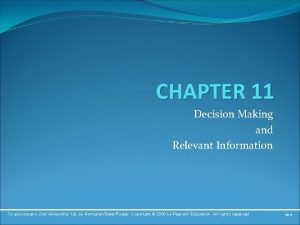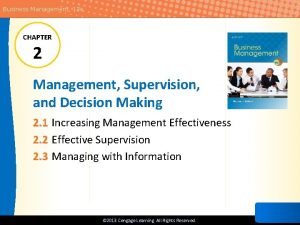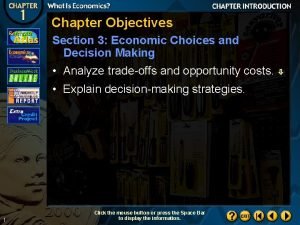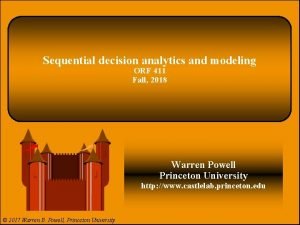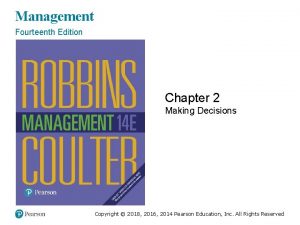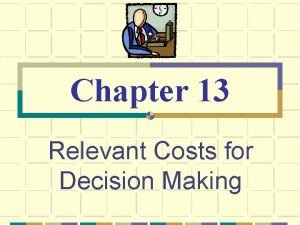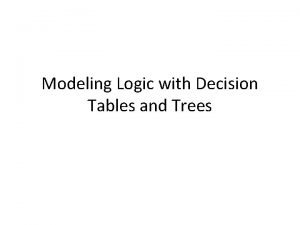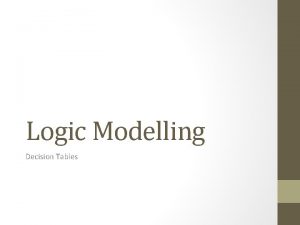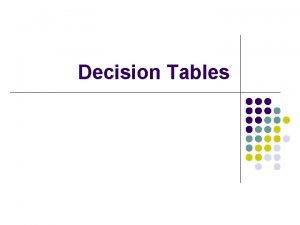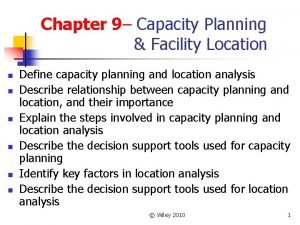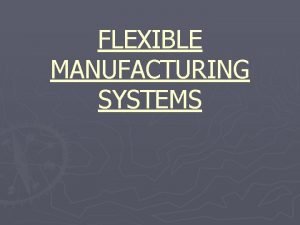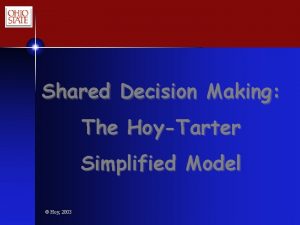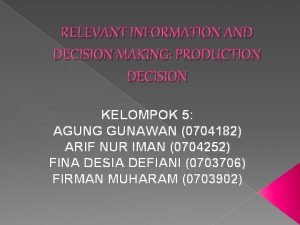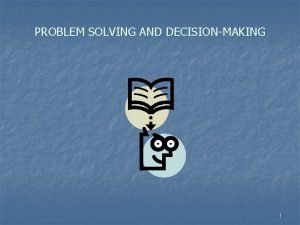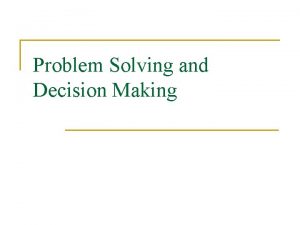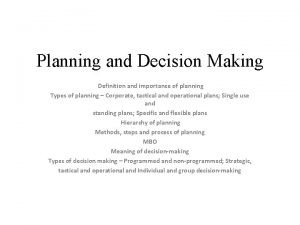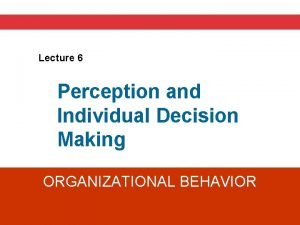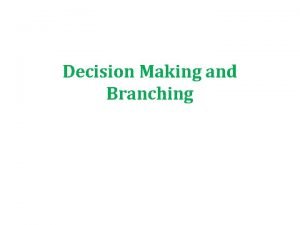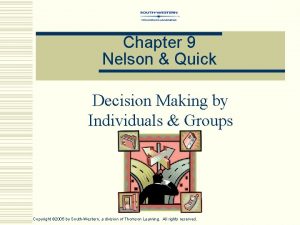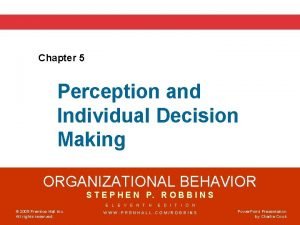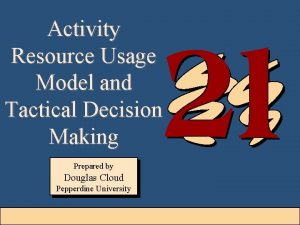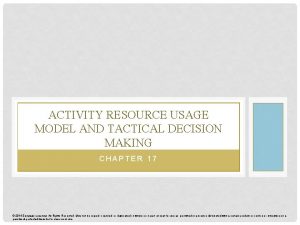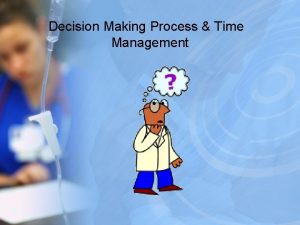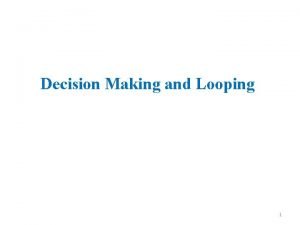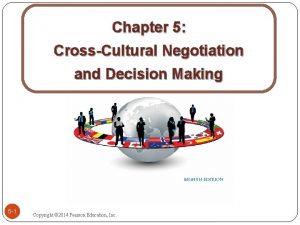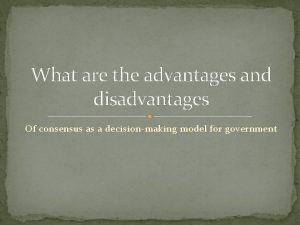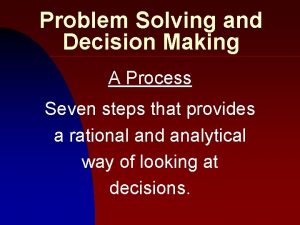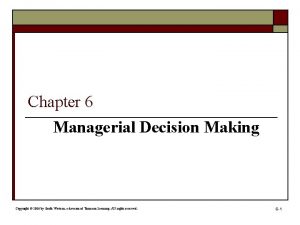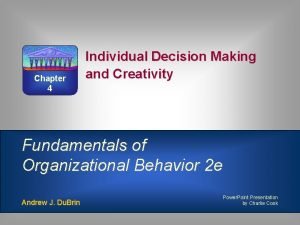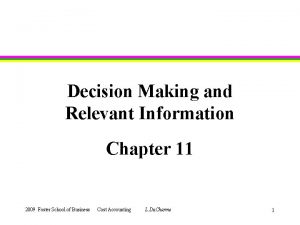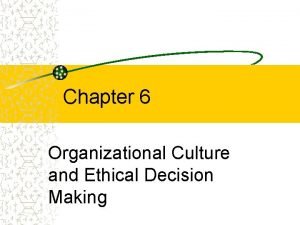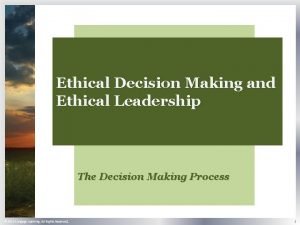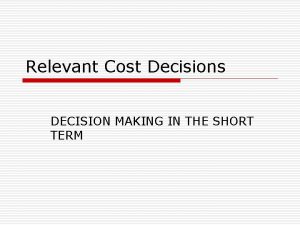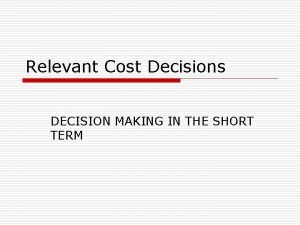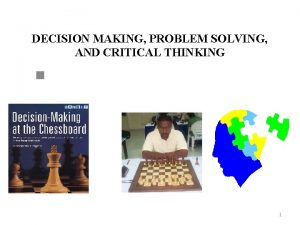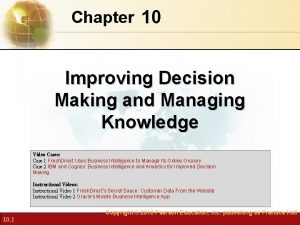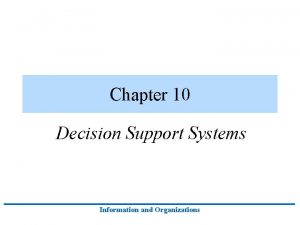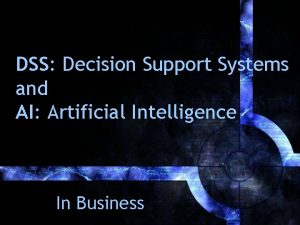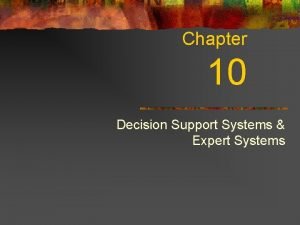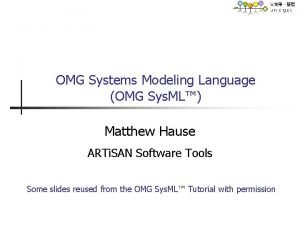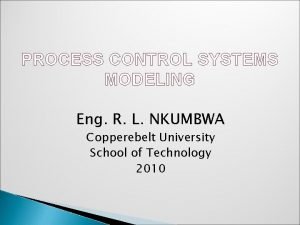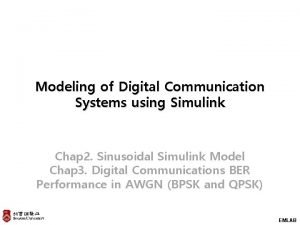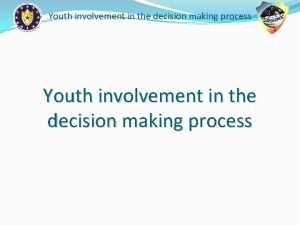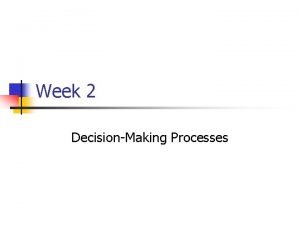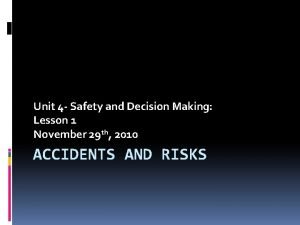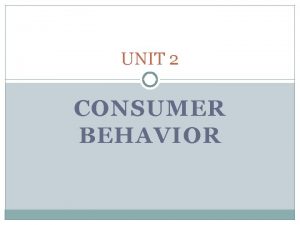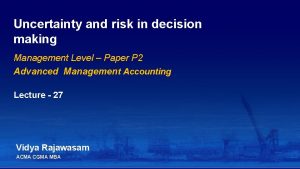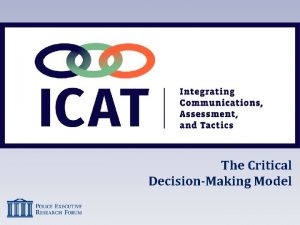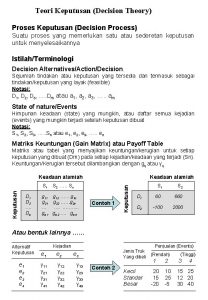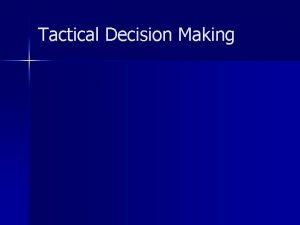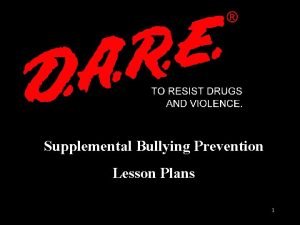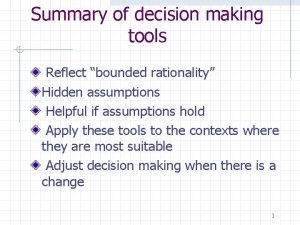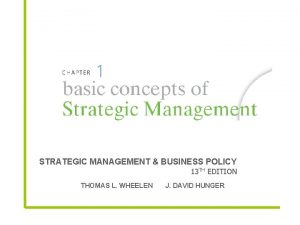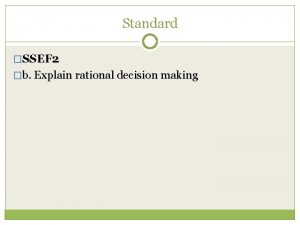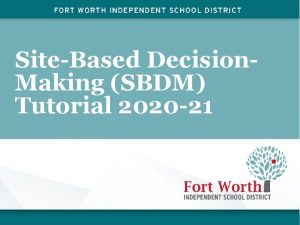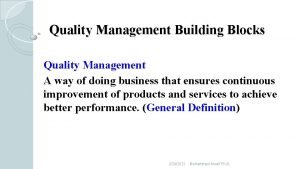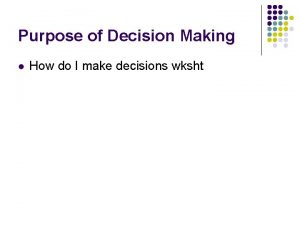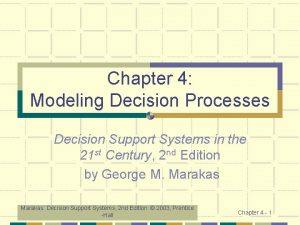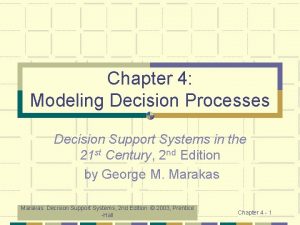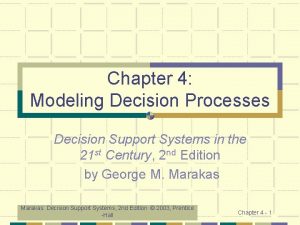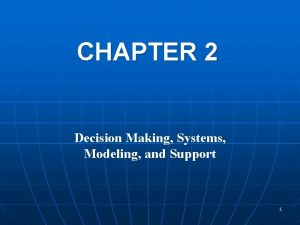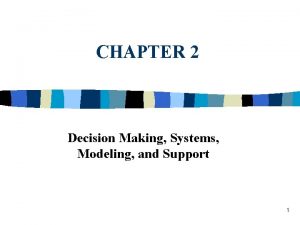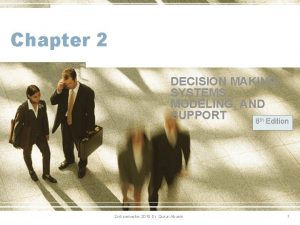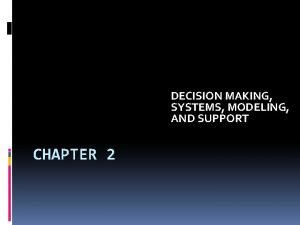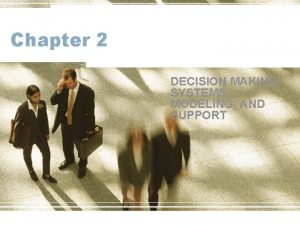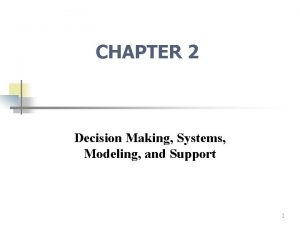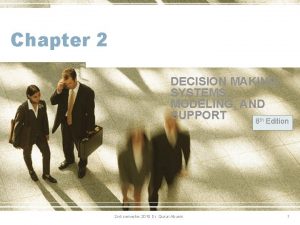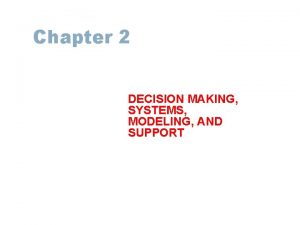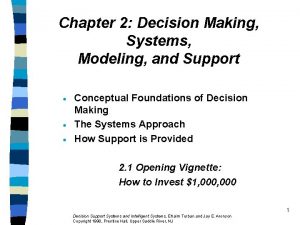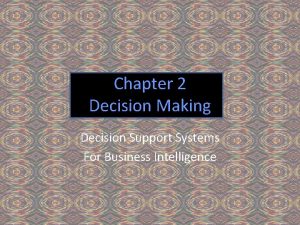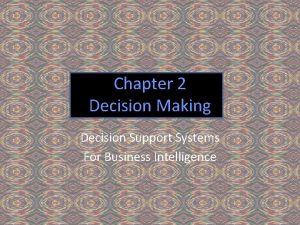CHAPTER 2 Decision Making Systems Modeling and Support




































































































- Slides: 100

CHAPTER 2 Decision Making, Systems, Modeling, and Support 1

Decision Making, Systems, Modeling, and Support · · Conceptual Foundations of Decision Making The Systems Approach How Support is Provided Opening Vignette: How to Invest $10, 000 2

Typical Business Decision Aspects n n n n Decision may be made by a group Group member biases Groupthink Several, possibly contradictory objectives Many alternatives Results can occur in the future Attitudes towards risk Need information Gathering information takes time and expense Too much information “What-if” scenarios Trial-and-error experimentation with the real system may result in a loss Experimentation with the real system - only once Changes in the environment can occur continuously Time pressure 3

n How are decisions made? ? ? n What methodologies can be applied? n What is the role of information systems in supporting decision making? DSS n n n Decision Support Systems 4

Decision Making n Decision Making: a process of choosing among alternative courses of action for the purpose of attaining a goal or goals n Managerial Decision Making is synonymous with the whole process of management (Simon, 1977) 5

Decision Making versus Problem Solving Simon’s 4 Phases of Decision Making 1. Intelligence 2. Design 3. Choice 4. Implementation Decision making and problem solving are interchangeable 6

7

Systems n A SYSTEM is a collection of objects such as people, resources, concepts, and procedures intended to perform an identifiable function or to serve a goal n System Levels (Hierarchy): All systems are subsystems interconnected through interfaces 8

The Structure of a System Three Distinct Parts of Systems (Figure 2. 1) n n n Inputs Processes Outputs Systems n n Surrounded by an environment Frequently include feedback The decision maker is usually considered part of the system Decision Support Systems and Intelligent Systems, Efraim Turban and Jay E. Aronson, 6 th edition, Copyright 2001, Prentice Hall, Upper Saddle River, NJ 9

10

n Inputs are elements that enter the system n Processes convert or transform inputs into outputs n Outputs describe finished products or consequences of being in the system n Feedback is the flow of information from the output to the decision maker, who may modify the inputs or the processes (closed loop) n The Environment contains the elements that lie outside but impact the system's performance 11

How to Identify the Environment? Two Questions (Churchman, 1975) 1. Does the element matter relative to the system's goals? [YES] 2. Is it possible for the decision maker to significantly manipulate this element? [NO] 12

Environmental Elements Can Be n n n Social Political Legal Physical Economical Often Other Systems 13

The Boundary Separates a System From Its Environment Boundaries may be physical or nonphysical (by definition of scope or time frame) Information system boundaries are usually by definition! 14

Closed and Open Systems Defining manageable boundaries is closing the system n A Closed System is totally independent of other systems and subsystems n An Open System is very dependent on its environment 15

16

An Information System n Collects, processes, stores, analyzes, and disseminates information for a specific purpose n Is often at the heart of many organizations n Accepts inputs and processes data to provide information to decision makers and helps decision makers communicate their results 17

System Effectiveness and Efficiency Two Major Classes of Performance Measurement n Effectiveness is the degree to which goals are achieved Doing the right thing! n Efficiency is a measure of the use of inputs (or resources) to achieve outputs Doing the thing right! n MSS emphasize effectiveness Often: several non-quantifiable, conflicting goals 18

Models n n n Major component of DSS Use models instead of experimenting on the real system A model is a simplified representation or abstraction of reality. Reality is generally too complex to copy exactly Much of the complexity is actually irrelevant in problem solving 19

Degrees of Model Abstraction (Least to Most) n Iconic (Scale) Model: Physical replica of a system n Analog Model behaves like the real system but does not look like it (symbolic representation) n Mathematical (Quantitative) Models use mathematical relationships to represent complexity Used in most DSS analyses 20

Benefits of Models 1. Time compression 2. Easy model manipulation 3. Low cost of construction 4. Low cost of execution (especially that of errors) 5. Can model risk and uncertainty 6. Can model large and extremely complex systems with possibly infinite solutions 7. Enhance and reinforce learning, and enhance training. Computer graphics advances: more iconic and analog models (visual simulation) 21

The Modeling Process-A Preview n n How Much to Order for the Ma-Pa Grocery? Bob and Jan: How much bread to stock each day? Solution Approaches n n Trial-and-Error Simulation Optimization Heuristics 22

The Decision-Making Process Systematic Decision-Making Process (Simon, 1977) n n Intelligence Design Choice Implementation (Figure 2. 2) Modeling is Essential to the Process 23

24

n Intelligence phase n n n Design phase n n n Representative model is constructed The model is validated and evaluation criteria are set Choice phase n n n Reality is examined The problem is identified and defined Includes a proposed solution to the model If reasonable, move on to the Implementation phase n Solution to the original problem Failure: Return to the modeling process Decision. Backtrack Support Systems and Intelligent Systems, Efraim Turban and Jay the E. Aronson, 6 th edition, Often / Cycle Throughout Process Copyright 2001, Prentice Hall, Upper Saddle River, NJ 25

The Intelligence Phase Scan the environment to identify problem situations or opportunities Find the Problem n n n Identify organizational goals and objectives Determine whether they are being met Explicitly define the problem Decision Support Systems and Intelligent Systems, Efraim Turban and Jay E. Aronson, 6 th edition, Copyright 2001, Prentice Hall, Upper Saddle River, NJ 26

Problem Classification Structured versus Unstructured Programmed versus Nonprogrammed Problems Simon (1977) Nonprogrammed Problems Programmed Problems Decision Support Systems and Intelligent Systems, Efraim Turban and Jay E. Aronson, 6 th edition, Copyright 2001, Prentice Hall, Upper Saddle River, NJ 27

n Problem Decomposition: Divide a complex problem into (easier to solve) subproblems Chunking (Salami) n Some seemingly poorly structured problems may have some highly structured subproblems n Problem Ownership Outcome: Problem Statement Decision Support Systems and Intelligent Systems, Efraim Turban and Jay E. Aronson, 6 th edition, Copyright 2001, Prentice Hall, Upper Saddle River, NJ 28

The Design Phase n Generating, developing, and analyzing possible courses of action Includes n n n Understanding the problem Testing solutions for feasibility A model is constructed, tested, and validated Modeling n n Conceptualization of the problem Abstraction to quantitative and/or qualitative forms Decision Support Systems and Intelligent Systems, Efraim Turban and Jay E. Aronson, 6 th edition, Copyright 2001, Prentice Hall, Upper Saddle River, NJ 29

Mathematical Model n n Identify variables Establish equations describing their relationships Simplifications through assumptions Balance model simplification and the accurate representation of reality Modeling: an art and science Decision Support Systems and Intelligent Systems, Efraim Turban and Jay E. Aronson, 6 th edition, Copyright 2001, Prentice Hall, Upper Saddle River, NJ 30

Quantitative Modeling Topics n n n n Model Components Model Structure Selection of a Principle of Choice (Criteria for Evaluation) Developing (Generating) Alternatives Predicting Outcomes Measuring Outcomes Scenarios Decision Support Systems and Intelligent Systems, Efraim Turban and Jay E. Aronson, 6 th edition, Copyright 2001, Prentice Hall, Upper Saddle River, NJ 31

Components of Quantitative Models n n n Decision Variables Uncontrollable Variables (and/or Parameters) Result (Outcome) Variables Mathematical Relationships or Symbolic or Qualitative Relationships (Figure 2. 3) Decision Support Systems and Intelligent Systems, Efraim Turban and Jay E. Aronson, 6 th edition, Copyright 2001, Prentice Hall, Upper Saddle River, NJ 32

33

Results of Decisions are Determined by the n n n Decision Uncontrollable Factors Relationships among Variables Decision Support Systems and Intelligent Systems, Efraim Turban and Jay E. Aronson, 6 th edition, Copyright 2001, Prentice Hall, Upper Saddle River, NJ 34

Result Variables n n n Reflect the level of effectiveness of the system Dependent variables Examples - Table 2. 2 Decision Support Systems and Intelligent Systems, Efraim Turban and Jay E. Aronson, 6 th edition, Copyright 2001, Prentice Hall, Upper Saddle River, NJ 35

Decision Variables n n n Describe alternative courses of action The decision maker controls them Examples - Table 2. 2 Decision Support Systems and Intelligent Systems, Efraim Turban and Jay E. Aronson, 6 th edition, Copyright 2001, Prentice Hall, Upper Saddle River, NJ 36

Uncontrollable Variables or Parameters n n n Factors that affect the result variables Not under the control of the decision maker Generally part of the environment Some constrain the decision maker and are called constraints Examples - Table 2. 2 Intermediate Result Variables n Reflect intermediate outcomes Decision Support Systems and Intelligent Systems, Efraim Turban and Jay E. Aronson, 6 th edition, Copyright 2001, Prentice Hall, Upper Saddle River, NJ 37

38

The Structure of Quantitative Models n Mathematical expressions (e. g. , equations or inequalities) connect the components n Simple financial model P=R-C n Present-value model P = F / (1+i)n Decision Support Systems and Intelligent Systems, Efraim Turban and Jay E. Aronson, 6 th edition, Copyright 2001, Prentice Hall, Upper Saddle River, NJ 39

LP Example The Product-Mix Linear Programming Model n n n MBI Corporation Decision: How many computers to build next month? Two types of computers Labor limit Materials limit Marketing lower limits Constraint Labor (days) Materials $ Units Profit $ CC 7 300 10, 000 1 8, 000 CC 8 500 15, 000 1 12, 000 Rel <= <= >= >= Max Limit 200, 000 / mo 8, 000/mo 100 200 Objective: Maximize Total Profit / Month Decision Support Systems and Intelligent Systems, Efraim Turban and Jay E. Aronson, 6 th edition, Copyright 2001, Prentice Hall, Upper Saddle River, NJ 40

Linear Programming Model n Components Decision variables Result variable Uncontrollable variables (constraints) n Solution X 1 = 333. 33 X 2 = 200 Profit = $5, 066, 667 Decision Support Systems and Intelligent Systems, Efraim Turban and Jay E. Aronson, 6 th edition, Copyright 2001, Prentice Hall, Upper Saddle River, NJ 41

42

Optimization Problems n n n Linear programming Goal programming Network programming Integer programming Transportation problem Assignment problem Nonlinear programming Dynamic programming Stochastic programming Investment models Simple inventory models Replacement models (capital budgeting) Decision Support Systems and Intelligent Systems, Efraim Turban and Jay E. Aronson, 6 th edition, Copyright 2001, Prentice Hall, Upper Saddle River, NJ 43

The Principle of Choice n n n What criteria to use? Best solution? Good enough solution? Decision Support Systems and Intelligent Systems, Efraim Turban and Jay E. Aronson, 6 th edition, Copyright 2001, Prentice Hall, Upper Saddle River, NJ 44

Selection of a Principle of Choice Not the choice phase A decision regarding the acceptability of a solution approach n n Normative Descriptive Decision Support Systems and Intelligent Systems, Efraim Turban and Jay E. Aronson, 6 th edition, Copyright 2001, Prentice Hall, Upper Saddle River, NJ 45

Normative Models n The chosen alternative is demonstrably the best of all (normally a good idea) n Optimization process n Normative decision theory based on rational decision makers Decision Support Systems and Intelligent Systems, Efraim Turban and Jay E. Aronson, 6 th edition, Copyright 2001, Prentice Hall, Upper Saddle River, NJ 46

Rationality Assumptions n Humans are economic beings whose objective is to maximize the attainment of goals; that is, the decision maker is rational n In a given decision situation, all viable alternative courses of action and their consequences, or at least the probability and the values of the consequences, are known n Decision makers have an order or preference that enables them to rank the desirability of all consequences of the analysis Decision Support Systems and Intelligent Systems, Efraim Turban and Jay E. Aronson, 6 th edition, Copyright 2001, Prentice Hall, Upper Saddle River, NJ 47

Suboptimization n Narrow the boundaries of a system n Consider a part of a complete system n Leads to (possibly very good, but) non-optimal solutions n Viable method Decision Support Systems and Intelligent Systems, Efraim Turban and Jay E. Aronson, 6 th edition, Copyright 2001, Prentice Hall, Upper Saddle River, NJ 48

Descriptive Models n n n Describe things as they are, or as they are believed to be Extremely useful in DSS for evaluating the consequences of decisions and scenarios No guarantee a solution is optimal Often a solution will be good enough Simulation: Descriptive modeling technique Decision Support Systems and Intelligent Systems, Efraim Turban and Jay E. Aronson, 6 th edition, Copyright 2001, Prentice Hall, Upper Saddle River, NJ 49

Descriptive Models n n n n Information flow Scenario analysis Financial planning Complex inventory decisions Markov analysis (predictions) Environmental impact analysis Simulation Waiting line (queue) management Decision Support Systems and Intelligent Systems, Efraim Turban and Jay E. Aronson, 6 th edition, Copyright 2001, Prentice Hall, Upper Saddle River, NJ 50

Satisficing (Good Enough) n Most human decision makers will settle for a good enough solution n Tradeoff: time and cost of searching for an optimum versus the value of obtaining one n Good enough or satisficing solution may meet a certain goal level is attained (Simon, 1977) Decision Support Systems and Intelligent Systems, Efraim Turban and Jay E. Aronson, 6 th edition, Copyright 2001, Prentice Hall, Upper Saddle River, NJ 51

Why Satisfice? Bounded Rationality (Simon) n n n Humans have a limited capacity for rational thinking Generally construct and analyze a simplified model Behavior to the simplified model may be rational But, the rational solution to the simplified model may NOT BE rational in the real-world situation Rationality is bounded by n n n limitations on human processing capacities individual differences Bounded rationality: why many models are descriptive, not normative Decision Support Systems and Intelligent Systems, Efraim Turban and Jay E. Aronson, 6 th edition, Copyright 2001, Prentice Hall, Upper Saddle River, NJ 52

Developing (Generating) Alternatives n In Optimization Models: Automatically by the Model! Not Always So! n Issue: When to Stop? Decision Support Systems and Intelligent Systems, Efraim Turban and Jay E. Aronson, 6 th edition, Copyright 2001, Prentice Hall, Upper Saddle River, NJ 53

Predicting the Outcome of Each Alternative n n n Must predict the future outcome of each proposed alternative Consider what the decision maker knows (or believes) about the forecasted results Classify Each Situation as Under n n n Certainty Risk Uncertainty Decision Support Systems and Intelligent Systems, Efraim Turban and Jay E. Aronson, 6 th edition, Copyright 2001, Prentice Hall, Upper Saddle River, NJ 54

55

Decision Making Under Certainty n n Assumes complete knowledge available (deterministic environment) Example: U. S. Treasury bill investment Typically for structured problems with short time horizons Sometimes DSS approach is needed for certainty situations Decision Support Systems and Intelligent Systems, Efraim Turban and Jay E. Aronson, 6 th edition, Copyright 2001, Prentice Hall, Upper Saddle River, NJ 56

Decision Making Under Risk (Risk Analysis) n n Probabilistic or stochastic decision situation Must consider several possible outcomes for each alternative, each with a probability Long-run probabilities of the occurrences of the given outcomes are assumed known or estimated Assess the (calculated) degree of risk associated with each alternative Decision Support Systems and Intelligent Systems, Efraim Turban and Jay E. Aronson, 6 th edition, Copyright 2001, Prentice Hall, Upper Saddle River, NJ 57

Risk Analysis n Calculate the expected value of each alternative n Select the alternative with the best expected value n Example: poker game with some cards face up (7 card game - 2 down, 4 up, 1 down) Decision Support Systems and Intelligent Systems, Efraim Turban and Jay E. Aronson, 6 th edition, Copyright 2001, Prentice Hall, Upper Saddle River, NJ 58

Decision Making Under Uncertainty n n n Several outcomes possible for each course of action BUT the decision maker does not know, or cannot estimate the probability of occurrence More difficult - insufficient information Assessing the decision maker's (and/or the organizational) attitude toward risk Example: poker game with no cards face up (5 card stud or draw) Decision Support Systems and Intelligent Systems, Efraim Turban and Jay E. Aronson, 6 th edition, Copyright 2001, Prentice Hall, Upper Saddle River, NJ 59

Measuring Outcomes n n n Goal attainment Maximize profit Minimize cost Customer satisfaction level (minimize number of complaints) Maximize quality or satisfaction ratings (surveys) Decision Support Systems and Intelligent Systems, Efraim Turban and Jay E. Aronson, 6 th edition, Copyright 2001, Prentice Hall, Upper Saddle River, NJ 60

Scenarios Useful in n n Simulation What-if analysis Decision Support Systems and Intelligent Systems, Efraim Turban and Jay E. Aronson, 6 th edition, Copyright 2001, Prentice Hall, Upper Saddle River, NJ 61

Importance of Scenarios in MSS n n n Help identify potential opportunities and/or problem areas Provide flexibility in planning Identify leading edges of changes that management should monitor Help validate major assumptions used in modeling Help check the sensitivity of proposed solutions to changes in scenarios Decision Support Systems and Intelligent Systems, Efraim Turban and Jay E. Aronson, 6 th edition, Copyright 2001, Prentice Hall, Upper Saddle River, NJ 62

Possible Scenarios n Worst possible (low demand, high cost) Best possible (high demand, high revenue, low cost) Most likely (median or average values) Many more n The scenario sets the stage for the analysis n n n Decision Support Systems and Intelligent Systems, Efraim Turban and Jay E. Aronson, 6 th edition, Copyright 2001, Prentice Hall, Upper Saddle River, NJ 63

64

The Choice Phase n The CRITICAL act - decision made here! n Search, evaluation, and recommending an appropriate solution to the model n Specific set of values for the decision variables in a selected alternative The problem is considered solved only after the recommended solution to the model is successfully implemented Decision Support Systems and Intelligent Systems, Efraim Turban and Jay E. Aronson, 6 th edition, Copyright 2001, Prentice Hall, Upper Saddle River, NJ 65

Search Approaches n Analytical Techniques n Algorithms (Optimization) n Blind and Heuristic Search Techniques Decision Support Systems and Intelligent Systems, Efraim Turban and Jay E. Aronson, 6 th edition, Copyright 2001, Prentice Hall, Upper Saddle River, NJ 66

67

68

69

Evaluation: Multiple Goals, Sensitivity Analysis, What-If, and Goal Seeking n n n Evaluation (with the search process) leads to a recommended solution Multiple goals Complex systems have multiple goals Some may conflict n Typically, quantitative models have a single goal n Can transform a multiple-goal problem into a singlegoal problem Decision Support Systems and Intelligent Systems, Efraim Turban and Jay E. Aronson, 6 th edition, Copyright 2001, Prentice Hall, Upper Saddle River, NJ 70

Common Methods n n n Utility theory Goal programming Expression of goals as constraints, using linear programming Point system Computerized models can support multiple goal decision making Decision Support Systems and Intelligent Systems, Efraim Turban and Jay E. Aronson, 6 th edition, Copyright 2001, Prentice Hall, Upper Saddle River, NJ 71

Sensitivity Analysis n Change inputs or parameters, look at model results Sensitivity analysis checks relationships Types of Sensitivity Analyses n n Automatic Trial and error Decision Support Systems and Intelligent Systems, Efraim Turban and Jay E. Aronson, 6 th edition, Copyright 2001, Prentice Hall, Upper Saddle River, NJ 72

Trial and Error n n n Change input data and re-solve the problem Better and better solutions can be discovered How to do? Easy in spreadsheets (Excel) n n What-if Goal seeking Decision Support Systems and Intelligent Systems, Efraim Turban and Jay E. Aronson, 6 th edition, Copyright 2001, Prentice Hall, Upper Saddle River, NJ 73

Goal Seeking n n n Backward solution approach Example: Figure 2. 10 What interest rate causes an the net present value of an investment to break even? In a DSS the what-if and the goal-seeking options must be easy to perform Decision Support Systems and Intelligent Systems, Efraim Turban and Jay E. Aronson, 6 th edition, Copyright 2001, Prentice Hall, Upper Saddle River, NJ 74

Goal Seeking Decision Support Systems and Intelligent Systems, Efraim Turban and Jay E. Aronson, 6 th edition, Copyright 2001, Prentice Hall, Upper Saddle River, NJ 75

The Implementation Phase There is nothing more difficult to carry out, nor more doubtful of success, nor more dangerous to handle, than to initiate a new order of things (Machiavelli, 1500 s) *** The Introduction of a Change *** Important Issues n n Resistance to change Degree of top management support Users’ roles and involvement in system development Users’ training Decision Support Systems and Intelligent Systems, Efraim Turban and Jay E. Aronson, 6 th edition, Copyright 2001, Prentice Hall, Upper Saddle River, NJ 76

How Decisions Are Supported Specific MSS technologies relationship to the decision making process (see Figure 2. 11) n n n Intelligence: DSS, ES, ANN, MIS, Data Mining, OLAP, EIS, GSS Design and Choice: DSS, ES, GSS, Management Science, ANN Implementation: DSS, ES, GSS Decision Support Systems and Intelligent Systems, Efraim Turban and Jay E. Aronson, 6 th edition, Copyright 2001, Prentice Hall, Upper Saddle River, NJ 77

78

Alternative Decision Making Models n n n n n Paterson decision-making process Kotter’s process model Pound’s flow chart of managerial behavior Kepner-Tregoe rational decision-making approach Hammond, Kenney, and Raiffa smart choice method Cougar’s creative problem solving concept and model Pokras problem-solving methodology Bazerman’s anatomy of a decision Harrison’s interdisciplinary approaches Beach’s naturalistic decision theories Decision Support Systems and Intelligent Systems, Efraim Turban and Jay E. Aronson, 6 th edition, Copyright 2001, Prentice Hall, Upper Saddle River, NJ 79

Naturalistic Decision Theories n n Focus on how decisions are made, not how they should be made Based on behavioral decision theory Recognition models Narrative-based models Decision Support Systems and Intelligent Systems, Efraim Turban and Jay E. Aronson, 6 th edition, Copyright 2001, Prentice Hall, Upper Saddle River, NJ 80

Recognition Models n n Policy Recognition-primed decision model Decision Support Systems and Intelligent Systems, Efraim Turban and Jay E. Aronson, 6 th edition, Copyright 2001, Prentice Hall, Upper Saddle River, NJ 81

Narrative-based Models (Descriptive) n n n Scenario model Story model Argument-driven action (ADA) model Incremental models Image theory Decision Support Systems and Intelligent Systems, Efraim Turban and Jay E. Aronson, 6 th edition, Copyright 2001, Prentice Hall, Upper Saddle River, NJ 82

Other Important Decision. Making Issues n n Personality types Gender Human cognition Decision styles Decision Support Systems and Intelligent Systems, Efraim Turban and Jay E. Aronson, 6 th edition, Copyright 2001, Prentice Hall, Upper Saddle River, NJ 83

Personality (Temperament) Types n n n Strong relationship between personality and decision making Type helps explain how to best attack a problem Type indicates how to relate to other types n important for team building n Influences cognitive style and decision style n http: //www. humanmetrics. com/cgi-win/JTypes 2. asp Decision Support Systems and Intelligent Systems, Efraim Turban and Jay E. Aronson, 6 th edition, Copyright 2001, Prentice Hall, Upper Saddle River, NJ 84

Myers-Briggs Dimensions n n Extraversion (E) to Intraversion (I) Sensation (S) to Intuition (N) Thinking (T) to Feeling (F) Perceiving (P) to Judging (J) Decision Support Systems and Intelligent Systems, Efraim Turban and Jay E. Aronson, 6 th edition, Copyright 2001, Prentice Hall, Upper Saddle River, NJ 85

86

Gender n n Sometimes empirical testing indicates gender differences in decision making Results are overwhelmingly inconclusive Decision Support Systems and Intelligent Systems, Efraim Turban and Jay E. Aronson, 6 th edition, Copyright 2001, Prentice Hall, Upper Saddle River, NJ 87

Cognition n Cognition: Activities by which an individual resolves differences between an internalized view of the environment and what actually exists in that same environment n Ability to perceive and understand information n Cognitive models are attempts to explain or understand various human cognitive processes Decision Support Systems and Intelligent Systems, Efraim Turban and Jay E. Aronson, 6 th edition, Copyright 2001, Prentice Hall, Upper Saddle River, NJ 88

Cognitive Style n The subjective process through which individuals perceive, organize, and change information during the decision-making process n Often determines people's preference for human-machine interface n Impacts on preferences for qualitative versus quantitative analysis and preferences for decision-making aids n Affects the way a decision maker frames a problem Decision Support Systems and Intelligent Systems, Efraim Turban and Jay E. Aronson, 6 th edition, Copyright 2001, Prentice Hall, Upper Saddle River, NJ 89

Cognitive Style Research n n Impacts on the design of management information systems May be overemphasized Analytic decision maker Heuristic decision maker Decision Support Systems and Intelligent Systems, Efraim Turban and Jay E. Aronson, 6 th edition, Copyright 2001, Prentice Hall, Upper Saddle River, NJ 90

Decision Styles The manner in which decision makers n n Think and react to problems Perceive their n n Cognitive response Values and beliefs Varies from individual to individual and from situation to situation Decision making is a nonlinear process The manner in which managers make decisions (and the way they interact with other people) describes their decision style n There are dozens Decision Support Systems and Intelligent Systems, Efraim Turban and Jay E. Aronson, 6 th edition, Copyright 2001, Prentice Hall, Upper Saddle River, NJ 91

Some Decision Styles n n n n Heuristic Analytic Autocratic Democratic Consultative (with individuals or groups) Combinations and variations For successful decision-making support, an MSS must fit the n n Decision situation Decision style Decision Support Systems and Intelligent Systems, Efraim Turban and Jay E. Aronson, 6 th edition, Copyright 2001, Prentice Hall, Upper Saddle River, NJ 92

n The system n n should be flexible and adaptable to different users have what-if and goal seeking have graphics have process flexibility n An MSS should help decision makers use and develop their own styles, skills, and knowledge n Different decision styles require different types of support n Major factor: individual or group decision maker Decision Support Systems and Intelligent Systems, Efraim Turban and Jay E. Aronson, 6 th edition, Copyright 2001, Prentice Hall, Upper Saddle River, NJ 93

94

The Decision Makers n n Individuals Groups Decision Support Systems and Intelligent Systems, Efraim Turban and Jay E. Aronson, 6 th edition, Copyright 2001, Prentice Hall, Upper Saddle River, NJ 95

Individuals n n May still have conflicting objectives Decisions may be fully automated Decision Support Systems and Intelligent Systems, Efraim Turban and Jay E. Aronson, 6 th edition, Copyright 2001, Prentice Hall, Upper Saddle River, NJ 96

Groups n n n n Most major decisions made by groups Conflicting objectives are common Variable size People from different departments People from different organizations The group decision-making process can be very complicated Consider Group Support Systems (GSS) Organizational DSS can help in enterprise-wide decision-making situations Decision Support Systems and Intelligent Systems, Efraim Turban and Jay E. Aronson, 6 th edition, Copyright 2001, Prentice Hall, Upper Saddle River, NJ 97

Summary n n n Managerial decision making is the whole process of management Problem solving also refers to opportunity's evaluation A system is a collection of objects such as people, resources, concepts, and procedures intended to perform an identifiable function or to serve a goal DSS deals primarily with open systems A model is a simplified representation or abstraction of reality Models enable fast and inexpensive experimentation with systems Decision Support Systems and Intelligent Systems, Efraim Turban and Jay E. Aronson, 6 th edition, Copyright 2001, Prentice Hall, Upper Saddle River, NJ 98

n n Modeling can employ optimization, heuristic, or simulation techniques Decision making involves four major phases: intelligence, design, choice, and implementation What-if and goal seeking are the two most common sensitivity analysis approaches Computers can support all phases of decision making by automating many required tasks Decision Support Systems and Intelligent Systems, Efraim Turban and Jay E. Aronson, 6 th edition, Copyright 2001, Prentice Hall, Upper Saddle River, NJ 99

Summary n n Personality (temperament) influences decision making Gender impacts on decision making are inconclusive Human cognitive styles may influence humanmachine interaction Human decision styles need to be recognized in designing MSS 100
 Decision support systems and intelligent systems
Decision support systems and intelligent systems Chapter 2 economic systems and decision making answer key
Chapter 2 economic systems and decision making answer key Chapter 2 economic systems and decision making
Chapter 2 economic systems and decision making Chapter 2 economic systems and decision making
Chapter 2 economic systems and decision making Objectives of decision making
Objectives of decision making Financial management process
Financial management process Decision support and business intelligence systems
Decision support and business intelligence systems Decision support system in business intelligence
Decision support system in business intelligence Expert system vs decision support system
Expert system vs decision support system Modeling role modeling theory
Modeling role modeling theory How do information systems aid in decision making
How do information systems aid in decision making Developing spreadsheet-based decision support systems
Developing spreadsheet-based decision support systems Dimensional modeling vs relational modeling
Dimensional modeling vs relational modeling Chapter 6 prices and decision making assessment answers
Chapter 6 prices and decision making assessment answers Chapter 11 decision making and relevant information
Chapter 11 decision making and relevant information Management chapter 5 planning and decision making
Management chapter 5 planning and decision making Chapter 11 decision making and relevant information
Chapter 11 decision making and relevant information Chapter 2 management supervision and decision making
Chapter 2 management supervision and decision making Decision making and relevant information
Decision making and relevant information Management chapter 5 planning and decision making
Management chapter 5 planning and decision making Chapter 1 section 3 economic choices and decision making
Chapter 1 section 3 economic choices and decision making Sequential decision analytics and modeling
Sequential decision analytics and modeling Financial decision-making process
Financial decision-making process Copyright
Copyright Relevant cost for decision making solution chapter 13
Relevant cost for decision making solution chapter 13 Modeling logic with decision tables
Modeling logic with decision tables Jan vanthienen
Jan vanthienen Decision logic table
Decision logic table Explain the decision tree modeling for capacity expansion
Explain the decision tree modeling for capacity expansion Manufacturing systems modeling and analysis
Manufacturing systems modeling and analysis Decision table and decision tree examples
Decision table and decision tree examples Using recursion in models and decision making
Using recursion in models and decision making Using recursion in models and decision making sheet 3
Using recursion in models and decision making sheet 3 Hoy model
Hoy model Decision making and relevant information
Decision making and relevant information Best books on problem solving and decision making
Best books on problem solving and decision making Individual and group decision making
Individual and group decision making Planning and decision making
Planning and decision making Perception and individual decision making
Perception and individual decision making A is a choice made from among available alternatives
A is a choice made from among available alternatives Decision making and branching example
Decision making and branching example Elements of planning
Elements of planning Horizontal solutions group synergy
Horizontal solutions group synergy What they see
What they see Decision making goal setting
Decision making goal setting Individual and group decision making
Individual and group decision making Activity resource usage model and tactical decision making
Activity resource usage model and tactical decision making Activity resource usage model and tactical decision making
Activity resource usage model and tactical decision making Decision making process definition
Decision making process definition Counter controlled
Counter controlled Cross cultural negotiation and decision making
Cross cultural negotiation and decision making What are some of the prominent advantages of consensus
What are some of the prominent advantages of consensus Problem space in psychology
Problem space in psychology 7 steps of problem solving and decision-making
7 steps of problem solving and decision-making Administrative decision making
Administrative decision making Sports and entertainment marketing performance indicators
Sports and entertainment marketing performance indicators Six decision making steps
Six decision making steps Decision making and creativity organizational behavior
Decision making and creativity organizational behavior Decision making and relevant information
Decision making and relevant information The role of corporate culture in ethical decision making
The role of corporate culture in ethical decision making Ethical habits
Ethical habits Decision making and relevant information
Decision making and relevant information Decision making and relevant information
Decision making and relevant information Traditional problem solving process nursing
Traditional problem solving process nursing The pattern of faulty and biased decision making
The pattern of faulty and biased decision making The pattern of faulty and biased decision making
The pattern of faulty and biased decision making Improving decision making and managing knowledge
Improving decision making and managing knowledge Group decision support and groupware technologies
Group decision support and groupware technologies Local area decision network
Local area decision network An expert system is
An expert system is Decision categories
Decision categories War making and state making as organized crime
War making and state making as organized crime What is major detail
What is major detail Omg systems modeling language
Omg systems modeling language Mathematical modelling of mechanical systems examples
Mathematical modelling of mechanical systems examples Control systems modeling
Control systems modeling Modeling of digital communication systems using simulink
Modeling of digital communication systems using simulink Modeling of digital communication systems using simulink
Modeling of digital communication systems using simulink Youth involvement
Youth involvement Social work code of ethics
Social work code of ethics Systematic decision making process
Systematic decision making process Paced decision making
Paced decision making What is this image
What is this image Unit 4 lesson 1 decision making
Unit 4 lesson 1 decision making Decision making to improve marketing performance
Decision making to improve marketing performance Types of decision making
Types of decision making Internal business management
Internal business management Decision making unit example
Decision making unit example Unstructured decision
Unstructured decision Role of marketing research
Role of marketing research Critical decision making model police
Critical decision making model police Contoh soal minimax regret
Contoh soal minimax regret Tactical decision making adalah
Tactical decision making adalah What is the dare decision making model
What is the dare decision making model Rational decision making model
Rational decision making model Mintzberg's modes of strategic decision making
Mintzberg's modes of strategic decision making Paced decision making
Paced decision making Conditions of decision making
Conditions of decision making Sbdm roles and responsibilities
Sbdm roles and responsibilities Decision making in healthcare
Decision making in healthcare Abcde decision making model
Abcde decision making model






